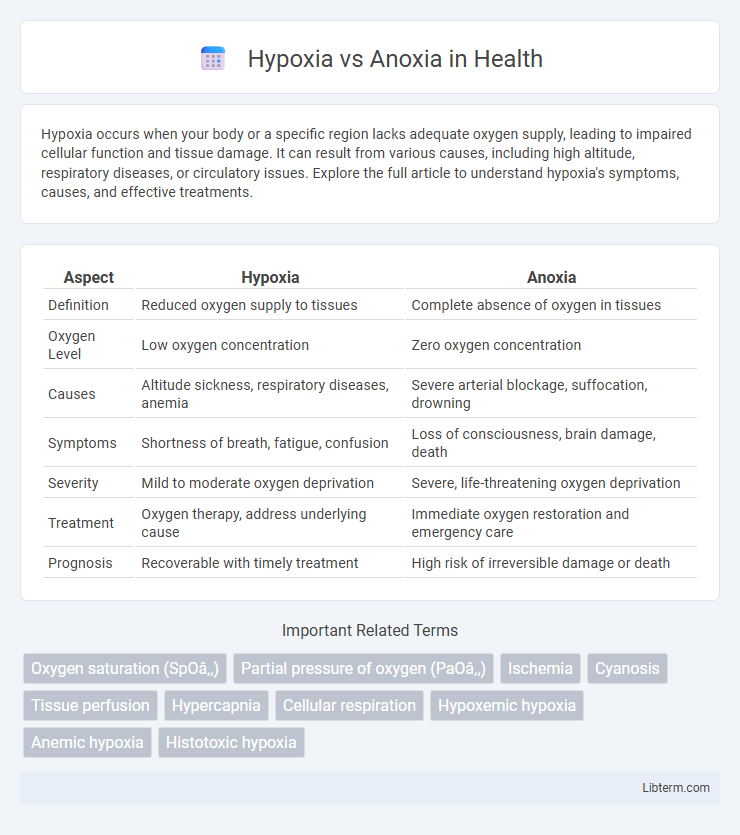Hypoxia occurs when your body or a specific region lacks adequate oxygen supply, leading to impaired cellular function and tissue damage. It can result from various causes, including high altitude, respiratory diseases, or circulatory issues. Explore the full article to understand hypoxia's symptoms, causes, and effective treatments.
Table of Comparison
| Aspect | Hypoxia | Anoxia |
|---|---|---|
| Definition | Reduced oxygen supply to tissues | Complete absence of oxygen in tissues |
| Oxygen Level | Low oxygen concentration | Zero oxygen concentration |
| Causes | Altitude sickness, respiratory diseases, anemia | Severe arterial blockage, suffocation, drowning |
| Symptoms | Shortness of breath, fatigue, confusion | Loss of consciousness, brain damage, death |
| Severity | Mild to moderate oxygen deprivation | Severe, life-threatening oxygen deprivation |
| Treatment | Oxygen therapy, address underlying cause | Immediate oxygen restoration and emergency care |
| Prognosis | Recoverable with timely treatment | High risk of irreversible damage or death |
Introduction to Hypoxia and Anoxia
Hypoxia refers to a condition where tissues experience an insufficient oxygen supply essential for cellular metabolism and function, while anoxia denotes the complete absence of oxygen in the tissues. Hypoxia can result from reduced oxygen availability in the environment, impaired blood flow, or decreased oxygen-carrying capacity of the blood, leading to cellular stress and potential injury. Anoxia, often more severe, causes rapid cellular damage and necrosis due to the total deprivation of oxygen necessary for aerobic respiration.
Defining Hypoxia: Causes and Mechanisms
Hypoxia occurs when tissues experience reduced oxygen availability, caused by factors such as respiratory diseases, anemia, or high altitudes that limit oxygen supply or transport. Cellular mechanisms respond to hypoxia by activating hypoxia-inducible factors (HIFs), which regulate gene expression to adapt metabolism and promote angiogenesis. Unlike anoxia, which is a complete lack of oxygen, hypoxia represents a partial oxygen deficiency that can lead to cellular dysfunction and tissue damage if prolonged.
Understanding Anoxia: Complete Oxygen Deprivation
Anoxia refers to the complete deprivation of oxygen in tissues, resulting in severe cellular damage and potential organ failure. Unlike hypoxia, which involves reduced oxygen availability, anoxia causes an absence of oxygen that impairs cellular respiration and energy production. Critical conditions such as stroke and cardiac arrest commonly result in anoxic injury, highlighting the urgency of timely intervention to restore oxygen supply.
Key Differences Between Hypoxia and Anoxia
Hypoxia refers to a condition where there is a reduced level of oxygen in tissues, while anoxia indicates a complete absence of oxygen supply. Hypoxia can be mild, moderate, or severe based on oxygen deprivation levels, but anoxia is characterized by total oxygen deficiency leading to more rapid cellular damage. The key distinction lies in the degree of oxygen deprivation: hypoxia involves insufficient oxygen, whereas anoxia means no oxygen at all, impacting cellular metabolism and survival differently.
Common Causes of Hypoxia and Anoxia
Hypoxia and anoxia are conditions characterized by reduced oxygen levels, with hypoxia indicating low oxygen and anoxia representing a complete lack of oxygen in tissues. Common causes of hypoxia include respiratory diseases such as chronic obstructive pulmonary disease (COPD), asthma, and pneumonia, as well as high altitude exposure and carbon monoxide poisoning. Anoxia commonly arises from conditions like cardiac arrest, stroke, severe anemia, and suffocation or drowning, all leading to total oxygen deprivation in affected tissues.
Physiological Effects on the Human Body
Hypoxia causes reduced oxygen availability leading to symptoms like shortness of breath, fatigue, and impaired cognitive function due to insufficient cellular oxygenation. Anoxia, being a complete lack of oxygen supply, results in severe tissue damage, organ failure, and if prolonged, irreversible brain injury or death. Both conditions disrupt cellular metabolism, but anoxia triggers more rapid and drastic physiological deterioration.
Signs and Symptoms of Oxygen Deprivation
Hypoxia presents with signs such as shortness of breath, rapid heartbeat, cyanosis, confusion, and fatigue, reflecting partial oxygen deprivation in tissues. Anoxia, characterized by a complete lack of oxygen, leads to severe symptoms including loss of consciousness, seizures, and potential brain damage. Both conditions require immediate medical attention to prevent irreversible cellular injury and organ failure.
Diagnosis and Detection Methods
Hypoxia is characterized by reduced oxygen availability to tissues, whereas anoxia signifies a complete absence of oxygen. Diagnosis of hypoxia often involves pulse oximetry, arterial blood gas analysis, and imaging techniques like MRI to assess tissue oxygenation levels. Detection of anoxia requires more immediate and precise methods, such as continuous EEG monitoring and biochemical markers, to identify severe oxygen deprivation and prevent irreversible damage.
Treatment and Management Strategies
Hypoxia treatment involves increasing oxygen delivery through methods such as supplemental oxygen therapy, mechanical ventilation, and addressing underlying causes like anemia or respiratory diseases. Anoxia management requires immediate restoration of oxygen supply to prevent irreversible tissue damage, often involving advanced interventions like hyperbaric oxygen therapy and emergency resuscitation protocols. Both conditions demand close monitoring of oxygen saturation levels and tailored therapeutic approaches based on severity and etiology to optimize patient outcomes.
Prevention and Risk Reduction Tips
Maintaining optimal oxygen levels in tissues prevents hypoxia and anoxia by ensuring proper ventilation and avoiding environments with low oxygen concentration. Using supplemental oxygen during high-risk conditions, such as respiratory illnesses or high altitudes, effectively reduces the risk of oxygen deprivation. Regular monitoring of blood oxygen saturation and managing underlying diseases like COPD or heart failure are critical strategies to minimize hypoxia and anoxia complications.
Hypoxia Infographic

 libterm.com
libterm.com